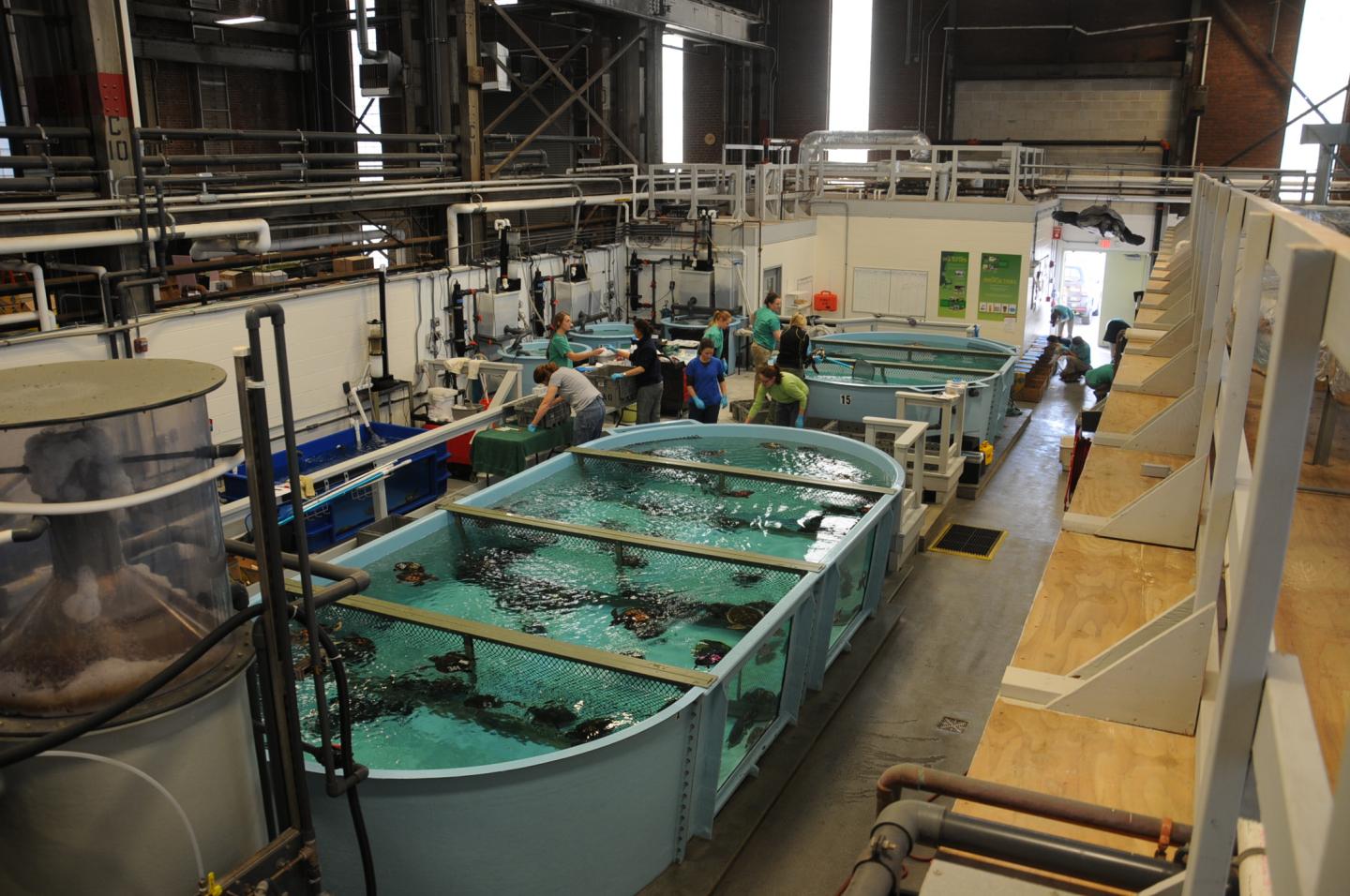A recent study looked into what variables are most important in predicting The number of cold-stunning and stranding events among juvenile Kemp’s ridley sea turtles in Cape Cod Bay

Credit: courtesy of New England Aquarium/Connie Merigo
AMHERST, Mass. – The number of cold-stunning and stranding events among juvenile Kemp’s ridley sea turtles, one of the world’s most endangered species, is increasing at an “alarming” rate and has moved north from Long Island Sound to Cape Cod Bay, say researchers at the University of Massachusetts Amherst, Mass Audubon and the University of Rhode Island. Their recent study looked into what variables are most important in predicting such events, to more effectively help the distressed reptiles.
First author of the new paper in the journal PLOS ONE this week is UMass Amherst conservation biologist Lucas Griffin, a Ph.D. candidate in marine science. As he and colleagues point out, climate change may present the broadest threat among many to sea turtle conservation, but not enough is understood about its potential effects on sea turtle cold-stunning events.
With long exposure to cold water, sea turtles can experience cold-stunning, a debilitating lethargy that often leads to death. All sea turtle species are susceptible, but juvenile Kemp’s ridley, loggerhead and green turtles are the most frequently cold-stunned species in the U.S. In northern waters, some young turtles fail to migrate south to the Gulf of Mexico before late autumn storms arrive and waters cool, the researchers point out.
Before 2009, observers saw only two years when numbers of cold-stunned turtles went over 100, Griffin says, but now that low number is rare. In 2014, more than 1,100 Kemp’s ridleys stranded in Cape Cod Bay. He points out, “We know so little about this critically endangered species and it’s really important for us to learn more to bolster their resilience, because the Gulf of Maine is expected to warm rapidly in the next few decades, which could lead to more turtles failing to leave in time.”
In the past, most Kemp’s ridley sea turtles likely ventured only as far north as Long Island in summer, where a few became stranded in the Sound. With much warmer waters in the Gulf of Maine every year, migrating turtles get caught by geography – the long arm of Cape Cod – which cuts off their route to the south, he explains.
Griffin says, “There were lots of statistics and a lot of information, but still uncertainty about what variables are most important to explain cold-stranding in these sea turtles. It’s a complex phenomenon, and the ocean operates on so many levels, it was very hard to boil it all down to a few important variables that might help us predict future trends.”
Their modeling, informed by machine learning and mathematical analysis of factors that influence the cold-stranding of hundreds of turtles in the Gulf of Maine and Cape Cod Bay each year, shows that sea-surface temperature (SST) in those waters between late October through early November, alone among hundreds of variables, best explained increasing numbers of cold-stunning events, Griffin and colleagues report.
They state, “Our model indicated that years with warmer SSTs in the Gulf of Maine in late summer through late fall produce higher numbers of cold-stun turtles on an annual basis. This is particularly alarming, considering the Gulf of Maine is predicted to continue to warm at a rapid rate in coming decades.”
Griffin explains, “With this study, we try to predict the future. We recognize that cold stunning is expected to increase dramatically and though it’s still a small proportion of the juveniles that are getting cold-stunned, we have to be careful because if their range is shifting north, that proportion may increase if more and more juveniles keep pushing north. We want to know if these juvenile turtles make it back to the Gulf of Mexico to reproduce, and we don’t know now.”
The authors point out that surprisingly, hatchlings released, a proxy measure for population abundance, was not identified as important by their model. Griffin says Kemp’s ridleys are faring better recently due to use of turtle-excluding devices in the shrimp fishery, limits on turtle egg harvesting and other conservation measures. Nesting numbers rose since the early 2000s but have leveled off for the past 10 years, he adds.
Cold-stranding is “one more danger they face before reaching maturity and breeding age,” he notes. The authors state, “Our predictions follow the observed trend and predict there may be as many as 2,349 Kemp’s ridley turtles cold-stunned annually in Cape Cod Bay by 2031.”
Griffin points out, “The rehabilitation process is expensive and labor intensive. We hope our research will be useful for volunteers and rescue organizations and will help them to plan and launch future conservation efforts.”
The researchers conclude, “While cold-stunning may currently account for a minor proportion of juvenile mortality, we recommend continuing efforts to rehabilitate cold-stunned individuals to maintain population resiliency for this critically endangered species in the face of a changing climate and continuing anthropogenic threats.”
The authors especially acknowledge volunteers and staff of the MassAudubon Wellfleet Bay Wildlife Sanctuary, New England Aquarium Rescue and Rehabilitation Department, members of the Cape Cod National Seashore involved in the Sea Turtle Stranding and Salvage Network and Gladys Porter Zoo, Brownsville, Texas, whose efforts have been “critical in the rehabilitation of thousands of cold-stunned sea turtles across the last 40 years.”
###
Media Contact
Janet Lathrop
[email protected]
413-545-2989
Original Source
https:/
Related Journal Article
http://dx.




